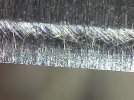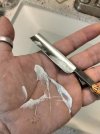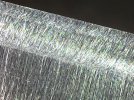It might be the practice at Thiers Issard and Dovo, but to the best of my knowledge, no other major razor makers do so. On the other hand, I'm not sure that there are any
really old razor makers left other than those two, and seeing how all the reference works relating to convex honing date to the mid-1800's, it's not surprising that this knowledge would have been lost or forgotten by the other manufacturers.
The other reason for this loss of knowledge is attributed to the use of Arkansas wheels for honing, beginning in the late 1800's and early 1900's. Production of those wheels stopped in the mid-1900's, and razor manufacturers purchased nearly the entire world supply, hoarding and using them. They used up the last of those about 40 years ago, at which point they reverted back to use of convex hones for honing. I'm not 100% sure of those dates, but that's the general gist of the history of convex honing.
I believe it's possible that convex honing may have been widespread in Europe at some time in the past, but that is certainly no longer the case.
Edit: as an interesting side note, many vintage Pierre Du Sud Ouest stones are found to be convex. Unfortunately, there is no historical reference as to why they were shaped so, or for what sharpening purpose they were used, so we can't use that fact as a convex razor hone reference.
The one craft that does still use convex hones, or at the very least, wheels, is the barber's sharpener. Barbers send their shears to specialists to be re-sharpened, not to the average Joe who runs a knife sharpening business, unless that person happens to be trained on the proper method of regrinding shears.
Sorry for completely derailing your thread, Bob, and for going far beyond the bounds of what you asked.
At the end of the day, the only person who really cares about the edge on your razor is the guy watching you from your mirror. Anyone else with a negative opinion on how YOU hone YOUR razor needs to check their ego at the door. After all, 20 years ago these same experts were using the pyramid honing method. 20 years from now, there will probably be other honing regimens that will take center stage. I don't foresee convex honing being that method, unless 3D printing makes shaped plates easily and cheaply accessible to the average person.
You know Jarrod
@thesuperiorshave is a member here, right? He just doesn't post here very often.


